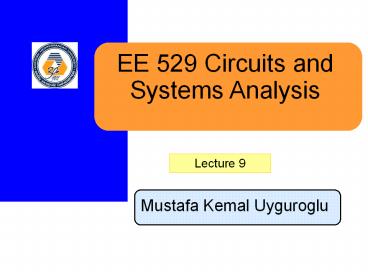EE 529 Circuit and Systems Analysis Lecture 9 - PowerPoint PPT Presentation
Title:
EE 529 Circuit and Systems Analysis Lecture 9
Description:
Lecture 9 State vector State equations Solution of state eq ns Homogenous solution State transition matrix Determination of (t): transform method Determination of ... – PowerPoint PPT presentation
Number of Views:87
Avg rating:3.0/5.0
Title: EE 529 Circuit and Systems Analysis Lecture 9
1
Lecture 9
2
State vector
a listing of state variables in vector form
3
State equations
System dynamics
Input vector
State vector
Measurement Read-out map
Output vector
4
xn-vector (state vector)
up-vector (input vector)
ym-vector (output vector)
n
Anxn
System matrix
n
p
Bnxp
Input (distribution) matrix
n
n
Cmxn
Output matrix
m
p
Dmxp
Direct-transmission matrix
m
5
Solution of state eqns
Consists of
Free response
(Homogenous soln)
(particular soln)
6
Homogenous solution
Homogenous equation
has the solution
State transition matrix
X(0)
7
State transition matrix
An nxn matrix ?(t), satisfying
8
Determination of ?(t) transform method
Laplace transform of the differential equation
9
Determination of ?(t) transform method
10
Determination of ?(t) time-domain solution
Scalar case
?
where
11
Determination of ?(t) time-domain solution
For vector case, by analogy
?
where
Can be verified by substitution.
12
Properties of TM
?(0)I
F(t)
F(-t)
?-1(t) ?(-t)
F(t2-t0)
F(t1-t0)
F(t2-t1)
?(t2-t1)F(t1-t0) F(t2-t0)
F(t)
F(t)
F(t)
F(t)
F(t)
F(t)
F(kt)
F(t)k F(kt)
13
General solution
Scalar case
14
General solution
Vector case
15
General solution transform method
L
?
?
16
Inverse Laplace transform yields
17
For initial time at tt0
18
The output
y(t)Cx(t)Du(t)
19
Example
- Obtain the state transition matrix ?(t) of the
following system. Obtain also the inverse of the
state transition matrix ?-1(t) .
For this system
the state transition matrix ?(t) is given by
since
20
Example
The inverse (sI-A) is given by
Hence
Noting that ?-1(t) ?(-t), we obtain the inverse
of transition matrix as
21
Exercise 1
- Find x1(t) , x2(t)
- The initial condition
22
Exercise 1 (Solution)
23
Example 2
24
Exercise 2
- Find x1(t) , x2(t)
- The initial condition
- Input is Unit Step
25
Exercise 2 (Solution)
26
Matrix Exponential eAt
27
Matrix Exponential eAt
28
The transformation where
?1,?2,,?n are distinct eigenvalues of A. This
transformation will transform P-1AP into the
diagonal matrix
29
Example 3
30
- Method 2
31
Matrix Exponential eAt
32
Matrix Exponential eAt
33
Example 4
34
Laplace Transform
35
(No Transcript)
36
(No Transcript)































